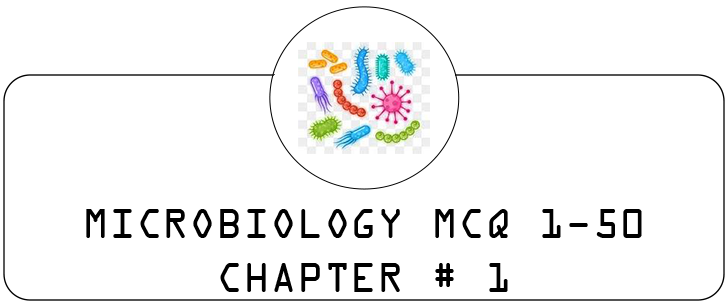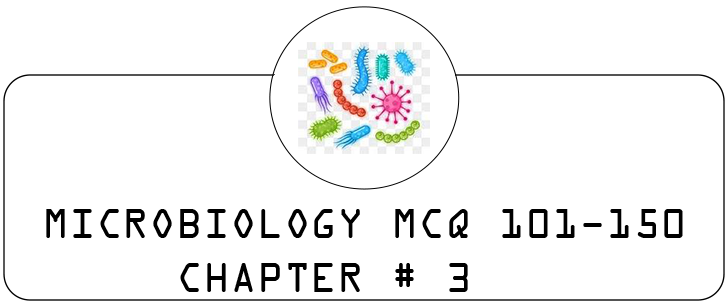
951. To produce monoclonal antibodies in large scale, the techniques that can be used are:
A. In vivo in the peritoneal cavity of mice
B. In vitro in large scale culture vessels
C. Both “A” and “B” ✅
D. Neither “A” nor “B”
A. In vivo in the peritoneal cavity of mice
B. In vitro in large scale culture vessels
C. Both “A” and “B” ✅
D. Neither “A” nor “B”
952. Which one of the following therapies can be suggested to cure a person who is suffering from spinal cord injuries?
A. Hybridoma
B. Gene therapy
C. Stem cell therapy ✅
D. Recombinant DNA technology
A. Hybridoma
B. Gene therapy
C. Stem cell therapy ✅
D. Recombinant DNA technology
953. cDNA, a term used in recombinant DNA technology means:
A. Competitive DNA
B. Chemical DNA
C. Complex DNA
D. Complementary DNA ✅
A. Competitive DNA
B. Chemical DNA
C. Complex DNA
D. Complementary DNA ✅
954. Which of the following enzyme is used in PCR?
A. Taq DNA polymerase ✅
B. HRP
C. EcoRI
D. EcoRII
A. Taq DNA polymerase ✅
B. HRP
C. EcoRI
D. EcoRII
955. Which of the following enzyme is used in ELISA?
A. Taq DNA polymerase
B. HRP ✅
C. EcoRI
D. EcoRII
A. Taq DNA polymerase
B. HRP ✅
C. EcoRI
D. EcoRII
956. Which of the following is helpful in distinguishing DNA of one individual from another?
A. PCR ✅
B. Reverse transcriptase
C. cDNA
D. RFLP
A. PCR ✅
B. Reverse transcriptase
C. cDNA
D. RFLP
957. Which of the following is the correct order of organization of genetic material from largest to smallest?
A. Genome, chromosome, gene, nucleotide ✅
B. Nucleotide, gene, chromosome, genome
C. Gene, nucleotide, chromosome, genome
D. Chromosome, genome, nucleotide, gene
A. Genome, chromosome, gene, nucleotide ✅
B. Nucleotide, gene, chromosome, genome
C. Gene, nucleotide, chromosome, genome
D. Chromosome, genome, nucleotide, gene
958. A hybridoma is:
A. A hybrid cell obtained by fusing a β–lymphocyte with a myeloma cell in vitro ✅
B. A hybrid cell obtained by fusing a β–lymphocyte with a myeloma cell in vivo
C. A hybrid cell obtained by fusing 2 β–lymphocyte cells in vitro
D. A hybrid cell obtained by fusing any 2 body cells in vitro
A. A hybrid cell obtained by fusing a β–lymphocyte with a myeloma cell in vitro ✅
B. A hybrid cell obtained by fusing a β–lymphocyte with a myeloma cell in vivo
C. A hybrid cell obtained by fusing 2 β–lymphocyte cells in vitro
D. A hybrid cell obtained by fusing any 2 body cells in vitro
959. Monoclonal antibodies are nowadays used in:
A. Disease diagnosis
B. Detection of specific type of pathogen
C. Very early and accurate detection of cancer
D. All of these ✅
A. Disease diagnosis
B. Detection of specific type of pathogen
C. Very early and accurate detection of cancer
D. All of these ✅
960. _______ is a non-essential amino acid.
A. Serine ✅
B. Threonine
C. Lysine
D. Histidine
A. Serine ✅
B. Threonine
C. Lysine
D. Histidine
961. Which of the following is an essential amino acid?
A. Cysteine
B. Asparagine
C. Glutamine
D. Phenylalanine ✅
A. Cysteine
B. Asparagine
C. Glutamine
D. Phenylalanine ✅
962. Peptide bond is a:
A. Covalent bond ✅
B. Ionic bond
C. Metallic bond
D. Hydrogen bond
A. Covalent bond ✅
B. Ionic bond
C. Metallic bond
D. Hydrogen bond
963. Which of the following is not a polysaccharide?
A. Starch
B. Cellulose
C. Glucose ✅
D. Glycogen
A. Starch
B. Cellulose
C. Glucose ✅
D. Glycogen
964. The chemical structure of a nucleic acid includes:
A. Ribose, deoxyribose, phosphate
B. Amino acids, phosphate, sugars
C. Sugars, bases, nucleotides ✅
D. Nucleotides, amino acids, fats
A. Ribose, deoxyribose, phosphate
B. Amino acids, phosphate, sugars
C. Sugars, bases, nucleotides ✅
D. Nucleotides, amino acids, fats
965. Which of the following statements about RNA is TRUE?
A. RNA contains thymine
B. RNA is usually single-stranded ✅
C. RNA is more stable than DNA
D. RNA cannot catalyze reactions
A. RNA contains thymine
B. RNA is usually single-stranded ✅
C. RNA is more stable than DNA
D. RNA cannot catalyze reactions
966. The genetic code is described as being:
A. Ambiguous
B. Degenerate ✅
C. Unambiguous
D. Both “B” and “C”
A. Ambiguous
B. Degenerate ✅
C. Unambiguous
D. Both “B” and “C”
967. The process of protein synthesis involves:
A. Replication
B. Transcription and translation ✅
C. Transduction
D. Transformation
A. Replication
B. Transcription and translation ✅
C. Transduction
D. Transformation
968. Which of the following are structural components of RNA?
A. Ribose
B. Uracil
C. Phosphate
D. All of these ✅
A. Ribose
B. Uracil
C. Phosphate
D. All of these ✅
969. In eukaryotes, which of the following processes occurs in the nucleus?
A. Transcription ✅
B. Translation
C. Replication
D. Both “A” and “C”
A. Transcription ✅
B. Translation
C. Replication
D. Both “A” and “C”
970. The start codon for protein synthesis is:
A. UAA
B. AUG ✅
C. UAG
D. ACG
A. UAA
B. AUG ✅
C. UAG
D. ACG
971. Which of the following is NOT a function of proteins?
A. Enzymatic activity
B. Genetic information storage ✅
C. Transport
D. Structural support
A. Enzymatic activity
B. Genetic information storage ✅
C. Transport
D. Structural support
972. Enzymes are:
A. Catalysts ✅
B. Proteins
C. Specific for their substrates
D. All of these
A. Catalysts ✅
B. Proteins
C. Specific for their substrates
D. All of these
973. A substrate is:
A. The product of an enzyme reaction
B. The molecule an enzyme acts upon ✅
C. A type of protein
D. A type of amino acid
A. The product of an enzyme reaction
B. The molecule an enzyme acts upon ✅
C. A type of protein
D. A type of amino acid
974. The enzyme responsible for DNA replication is:
A. DNA polymerase ✅
B. RNA polymerase
C. Ligase
D. Exonuclease
A. DNA polymerase ✅
B. RNA polymerase
C. Ligase
D. Exonuclease
975. The primary structure of a protein is:
A. The sequence of amino acids ✅
B. The folding of the polypeptide chain
C. The three-dimensional shape
D. The quaternary structure
A. The sequence of amino acids ✅
B. The folding of the polypeptide chain
C. The three-dimensional shape
D. The quaternary structure
976. Which of the following is a component of DNA?
A. Ribose
B. Deoxyribose ✅
C. Uracil
D. RNA
A. Ribose
B. Deoxyribose ✅
C. Uracil
D. RNA
977. The process of removing introns from pre-mRNA is called:
A. Splicing ✅
B. Capping
C. Polyadenylation
D. Transcription
A. Splicing ✅
B. Capping
C. Polyadenylation
D. Transcription
978. Which of the following are involved in the initiation of translation?
A. Ribosomes ✅
B. tRNA
C. mRNA
D. All of these
A. Ribosomes ✅
B. tRNA
C. mRNA
D. All of these
979. Which of the following statements is TRUE regarding amino acids?
A. They are the building blocks of proteins ✅
B. There are 20 different amino acids
C. They are linked by peptide bonds
D. All of these
A. They are the building blocks of proteins ✅
B. There are 20 different amino acids
C. They are linked by peptide bonds
D. All of these
980. A gene is:
A. A sequence of DNA that codes for a protein ✅
B. A type of RNA
C. A sequence of amino acids
D. A type of polysaccharide
A. A sequence of DNA that codes for a protein ✅
B. A type of RNA
C. A sequence of amino acids
D. A type of polysaccharide
981. Genetic mutations can result in:
A. Changes in protein structure ✅
B. Changes in enzyme activity
C. Genetic disorders
D. All of these
A. Changes in protein structure ✅
B. Changes in enzyme activity
C. Genetic disorders
D. All of these
982. The central dogma of molecular biology describes:
A. The flow of genetic information ✅
B. The structure of DNA
C. The function of proteins
D. The replication of DNA
A. The flow of genetic information ✅
B. The structure of DNA
C. The function of proteins
D. The replication of DNA
983. Genetic recombination can occur during:
A. Meiosis ✅
B. Mitosis
C. Both “A” and “B”
D. None of these
A. Meiosis ✅
B. Mitosis
C. Both “A” and “B”
D. None of these
984. Which of the following is an example of bacterial and yeast polysaccharide?
A. Starch
B. Glycogen
C. Cellulose
D. Dextran ✅
A. Starch
B. Glycogen
C. Cellulose
D. Dextran ✅
985. When all monosaccharides in a polysaccharide are same type, such type of a polysaccharide is called a:
A. Glycogen
B. Homoglycan ✅
C. Heteroglycan
D. Oligosaccharide
A. Glycogen
B. Homoglycan ✅
C. Heteroglycan
D. Oligosaccharide
986. Which of the following are the storage polysaccharides?
A. Glycogen ✅
B. Cellulose
C. Chitin
D. Glucose
A. Glycogen ✅
B. Cellulose
C. Chitin
D. Glucose
987. The most abundant immunoglobulin is:
A. IgA
B. IgE
C. IgG ✅
D. IgM
A. IgA
B. IgE
C. IgG ✅
D. IgM
988. Glucose is stored in plants as ________.
A. Glycogen
B. Starch ✅
C. Dextrin
D. Cellulose
A. Glycogen
B. Starch ✅
C. Dextrin
D. Cellulose
989. Glucose is stored in liver as ___________.
A. Glycogen ✅
B. Starch
C. Dextrin
D. Cellulose
A. Glycogen ✅
B. Starch
C. Dextrin
D. Cellulose
990. Which of the following are the structural polysaccharides?
A. Glycogen
B. Starch
C. Chitin ✅
D. Glucose
A. Glycogen
B. Starch
C. Chitin ✅
D. Glucose
991. Which of the following is analogous to starch?
A. Cellulose
B. Glycogen ✅
C. Sucrose
D. Chitin
A. Cellulose
B. Glycogen ✅
C. Sucrose
D. Chitin
992. Identify the purine base of nucleic acids in the following:
A. Cytosine
B. Thymine
C. Uracil
D. Adenine ✅
A. Cytosine
B. Thymine
C. Uracil
D. Adenine ✅
993. Which of the following are not the components of RNA?
A. Thymine ✅
B. Adenine
C. Guanine
D. Cytosine
A. Thymine ✅
B. Adenine
C. Guanine
D. Cytosine
994. What is the composition of nucleotide?
A. a sugar + a phosphate
B. a base + a sugar
C. a base + a phosphate
D. a base + a sugar + phosphate ✅
A. a sugar + a phosphate
B. a base + a sugar
C. a base + a phosphate
D. a base + a sugar + phosphate ✅
995. Group of adjacent nucleotides are joined by:
A. Phosphodiester bond ✅
B. Peptide bond
C. Ionic bond
D. Covalent bond
A. Phosphodiester bond ✅
B. Peptide bond
C. Ionic bond
D. Covalent bond
996. The sugar molecule in a nucleotide is:
A. Pentose ✅
B. Hexose
C. Tetrose
D. Triose
A. Pentose ✅
B. Hexose
C. Tetrose
D. Triose
997. Building blocks of nucleic acids are:
A. Nucleotides ✅
B. Nucleosides
C. Amino acids
D. Histones
A. Nucleotides ✅
B. Nucleosides
C. Amino acids
D. Histones
998. Number of hydrogen bonds between adenine and thymine?
A. One
B. Two ✅
C. Three
D. Four
A. One
B. Two ✅
C. Three
D. Four
999. Number of hydrogen bonds between guanine and cytosine?
A. One
B. Two
C. Three ✅
D. Four
A. One
B. Two
C. Three ✅
D. Four
1000. Arrangement of nucleotides in DNA can be seen by:
A. Ultracentrifuge
B. X-Ray crystallography ✅
C. Light microscope
D. Electron microscope
A. Ultracentrifuge
B. X-Ray crystallography ✅
C. Light microscope
D. Electron microscope





